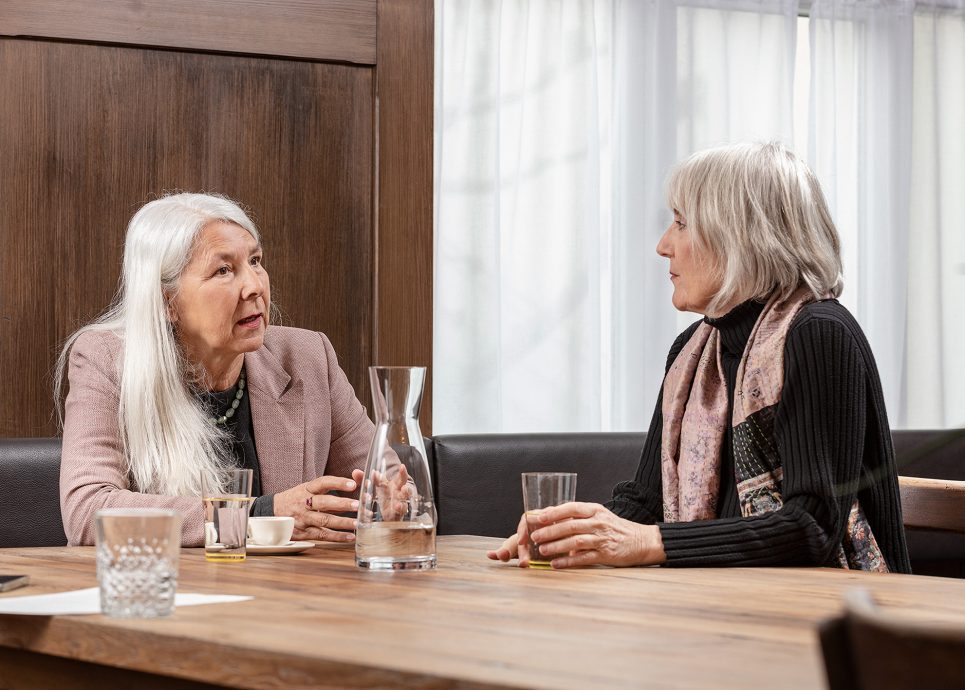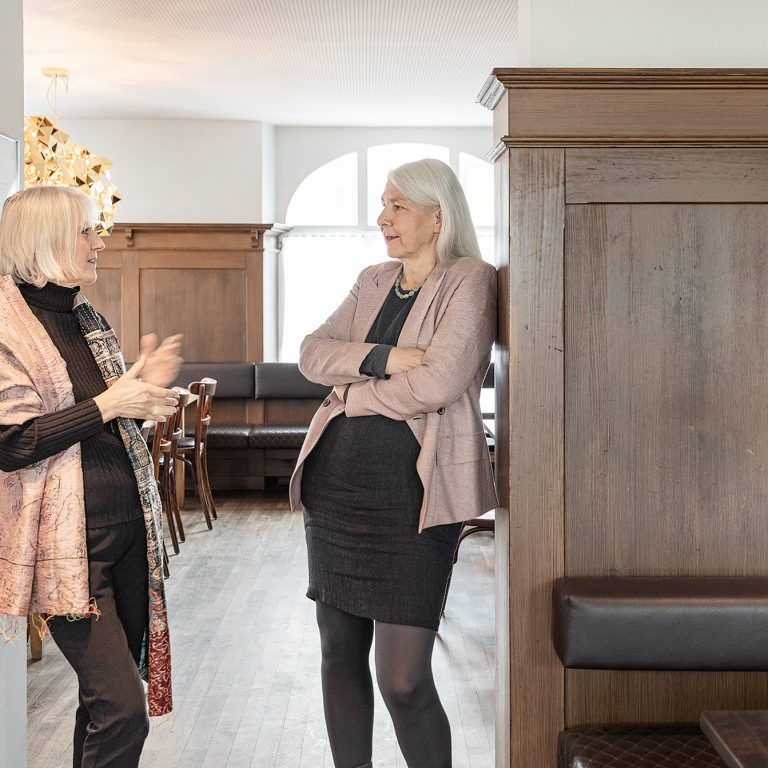


C Marina Hämmerle and Renate Breuß in Rankweil (c) Lukas Hämmerle
Inns – expressions of the art of life in Vorarlberg
TEXT: DANIELA KAULFUS
Lots of things are so much nicer to do in company. And one of them is stopping off at an inn. And writing is, on occasion, another. That’s what Marina Hämmerle also thought and joined Renate Breuß on a special trip of discovery through Vorarlberg, an exploration of establishments, so to speak. Or, rather, several of them. That’s because these two writing friends visited and portrayed several examples of the local hospitality culture – at establishments that were skilful expressions of both Vorarlberg’s architecture and culinary highlights. “Establishments that combine both are the showcases of our region,” the two think.
Marina Hämmerle brought her expertise as an architect and former director of vai – the Vorarlberg Architecture Institute – to the series. While craftsmanship and cooking are part of Renate Breuß’s lifeblood as she is an art historian and former managing director at the Werkraum Bregenzerwald. In their interview, they share how they chose the places they visited, their experiences there and which ones they’d recommend to guests travelling to Vorarlberg. And what did they discover for themselves? “Well, for me, it once again confirmed the wealth of places to go that’s on our doorsteps,” says Marina Hämmerle. While Renate Breuß found it “exciting to focus intentionally on both areas for once and to investigate what really creates an atmosphere”.
Exploration of Gasthaus Hörnlingen in Rankweil in Vorarlberg, taking a seat with Marina Hämmerle and Renate Breuß at one of the long dark tables in the beautiful wooden lounge there
Marina and Renate, you were responsible for the ‘Baukultur und Kulinarik’ series in which you described your trips to selected inns in Vorarlberg and wrote about them in such a way that really made readers want to try them out themselves. How did you choose which establishments to visit?
Renate Breuss (RB): We based our decisions on a variety of criteria. For example, a sense of consistency between the architecture and the culinary side, sustainability, continuity in the establishment’s management as well as creative and innovative aspects. Establishments that are pursuing experimental approaches were also included as long they seemed authentic to us.
Marina Hämmerle (MH): We wanted the stories to reveal a spectrum that appeals to all types of guest and to make what others are also experiencing apparent. We deliberately sought out the most diverse establishments to this end. Places where the palate and space work well together.
Were you more interested in buildings with a history or new ones?
RB: We were more interested in buildings with a history but we did not limit ourselves to those. The renovation of existing buildings is a greater challenge than building a new one because you have to respond to what’s already there and routine solutions don’t always work. The building we’re in (note: Gasthaus Hörnlingen) is an example of how well the proprietor and architect have worked with the design and structure of the existing building, which was built at the end of the 19th century.
The renovation of existing buildings is ultimately a greater challenge than building a new one because you have to respond to what’s already there and routine solutions don’t always work.
Is it about the preservation of the architecture?
RB: No, it’s not just about that, there are also radical breaks. The Jahnhalle, for example, features interventions into the old structure that are not apparent from the outside but that make new uses possible.
MH: The ‘Gams 1648’ (note: built in 1648) was also radically rethought. The building was taken back to its skeleton. The priority here was to create a new experience of space and open up the building.
Do we need more courageous people?
MH: We don’t regret our decision to focus on fewer new-build properties. Many great bars, clubs and restaurants in such cities as Vienna, New York and Amsterdam benefit from the flair that historic buildings offer. The proprietors are to be commended for preserving old structures and literally transforming them to meet the demands of contemporary hospitality.
RB: I think that establishments could be more courageous in pushing their cooperation with Vorarlberg’s farmers even further. Innkeepers are challengers: all the inns we visited demand good basic products and so promote quality in agricultural production.
The proprietors are to be commended for preserving old structures and literally transforming them to meet the demands of contemporary hospitality.
How are proprietors able to serve such quality dishes?
RB: They’re personally acquainted with their suppliers, they visit them and they choose, for example, what fish they want depending on the day’s catch right where they’re landed. Foragers bring chanterelles or home-made jams. Landlords and landladies work with the farmers, dairy people, vegetable growers. It’s the quality of these relationships that is ultimately expressed in dishes made from products that do not remain anonymous.
How is this quality communicated?
RB: Some of the proprietors simply tell us about it because they change their dishes on a daily basis and don’t offer extensive menus. But we also use our senses. We experience a consistency, a shape or a taste on the tongue, the beautiful wooden table I can run my hand along, the harmonious lighting or the tactile quality of curtains and fabrics. That’s the fun bit.
MH: It’s the same here at this place as well. The cooks don’t disappear into the kitchen never to be seen again, they’re the ones that serve the food and talk to the guests. Kitchens have become more approachable.
You’ve also had sushi, among other things, at the Rössle in Braz. How does that work at an inn in Vorarlberg?
RB: It was outstanding because the chef takes an extremely mindful approach to the food. That was particularly evident with that dish. It’s that personal mindset that’s decisive. It doesn’t always have to be Käsknöpfle (cheese dumplings) just because we’re in one of Vorarlberg’s timber-panelled inns.
MH: These types of surprise bring a cosmopolitan spirit to our traditional inns!
Are landlords and landladies expressing their own ideas more now than they used to?
MH: Perhaps more so now than in economic boom times when a lot of Alpine romanticism was imported and the existing was distorted. Proprietors were already aware of the effect of their interior spaces. And, today, there’s a desire to be authentic again. The proprietors we visited all had an understanding of design and an idea of what they wanted. There’s a sophistication that’s based on craftsmanship as well as an awareness of how important spaces are. You can feel it.
What effect does architecture have on people?
MH: Successful architecture is able to make you smile and trigger positive feelings through the senses. It sets the mood for a good meal. You look forward to the treat to come when the space is good.
RB: Even how you enter the establishment plays a role. The atmosphere starts at the threshold: people arrive, look around, take a moment. What’s the welcome like? And something that’s also important: what smells greet you? All of this is perceived subconsciously but, for me, it’s all part of the architecture!
You’ve visited a few inns. What do guests take away with them after spending some time there?
MH: It’s amazing, for example, that you encounter an urban feel at the inns that are located in rural settings. And how modern, sophisticated and cosmopolitan they seem. But, on the other hand, some of them make you feel like you’re at home – as if you were having coffee and cake with friends. It’s not only me who notices that, it’s also the international guests to the Schubertiade (note: the world’s most important festival that celebrates the composer Franz Schubert), who see that it’s family networks that carry the establishments and that everything is home-made.
RB: The guests are able to sense that nothing has been staged. That’s part of the mentality in Vorarlberg. There’s something urban about it.
The guests are able to sense that nothing has been staged.
Who were you writing for?
RB: I wanted to be an advocate for dining culture in Vorarlberg – and to be that for everyone!
MH: I was thinking of visitors from elsewhere and even young people living in Vorarlberg who might not yet have visited these establishments.
What would you say to visitors who want to get to know Vorarlberg as it is?
MH: If you really want to get to understand Vorarlberg, it’s not enough to just experience our idyllic valleys. It’s the mix of the semi-urban and rural mountain idyll that does it. The Rhine Valley as an urban space, as an in-between city, is absolutely part of it if you don’t want to leave out the big cultural venues, such as Kunsthaus Bregenz, or festivals, such as the poolbar in Feldkirch.
RB: If you wanted me to give you a name, I’d say the Rössle in Braz. It’s representative of a varied clientèle. It’s where both locals and pilgrims (Braz is located on the Camino de Santiago), young and old as well as regulars can come together. Even other innkeepers go there, which is a great vote of confidence.
Thank you very much for the interview!